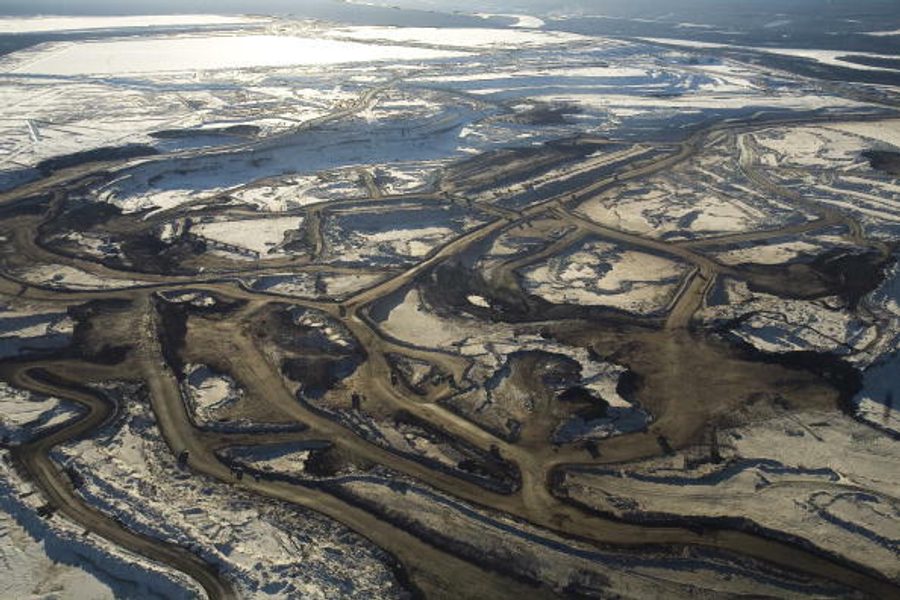The Next Keystone XL?
With TransCanada’s tar sands megaproject, a new front opens in North America’s pipeline wars.
Cole Stangler

The Keystone XL might be stalled for now. But that’s not getting in the way of the TransCanada Corporation’s plans to build an even bigger pipeline to transport tar sands — one of the dirtiest, most carbon-intensive fossil fuels on the planet.
If completed, the $12 billion Energy East pipeline, which TransCanada publicly announced last Thursday, could transport about a third more oil than the company’s Keystone XL project, or about 1.1 million barrels a day. The 2,734 mile-long pipeline would transport mostly export-destined bituminous sand from the Western Canadian province of Alberta to a seaside refinery in St. John, New Brunswick. A large portion of the project involves converting an existing gas pipeline to carry the heavy tar sands that originate from deposits in Alberta. But the company will also need to build some new pipelines, including a large pipeline stretching from eastern Ontario to the refinery in St. John. TransCanada anticipates the project to be complete by 2018.
The Energy East marks the latest attempt of the North American oil industry to take advantage of new export opportunities for tar sands, a commodity currently limited to the American market. The two other important pipeline projects that would link oil production in Alberta to global export markets have stalled — the Keystone XL, which would extend through the United States to the Gulf of Mexico, and Enbridge’s Northern Gateway, which would extend from Alberta to a port in British Columbia. To date environmental groups have managed to block those projects from being completed.
Andrea Harden-Donahue is the energy and climate justice campaigner for the Council of Canadians, one of the nation’s leading environmental groups. “This pipeline is critical for the oil industry. “If they are not successful in getting this pipeline going, as well as some of the others like the Keystone XL and Enbridge’s pipeline out west, they are literally going to be landlocked with bitumen in Alberta,” she says. “There are plans for massive expansion of the tar sands in that province, and quite frankly it just needs to go somewhere. In order to do that, they need these pipelines.”
Unlike the Keystone XL, the proposed Energy East route doesn’t actually enter U.S. territory. The pipeline loops around Northern Maine en route to St. John. Some say the company is deliberately avoiding the kinds of regulatory burdens that it has faced over the Keystone XL. Since that pipeline crosses international borders, it requires the final approval of the U.S. President.
“Why would you bother going through a presidential permit approval in the U.S. if you can avoid it?” asks Steven Guilbeault, head of Equiterre, an environmental organization based in Montreal. “Why do it when you have the Canadian federal government as a cheerleader of oil development in Canada?”
Canada’s Conservative government has indeed proven to be a trusted ally of tar sands development, which it regards as one of Canada’s most globally competitive industries. TransCanada needs to submit its application to the National Energy Board for environmental and regulatory review — a process whereby opponents will have the opportunity to present their cases against the pipeline. But if past projects are any indication, odds are that the federal government will approve the new pipeline.
John Bennett, executive director of Sierra Club Canada, says he’s already looking ahead to the next stage of the fight.
“We don’t have a possibility of a fair hearing in an environmental assessment sense for this pipeline. It’s going to get rubber-stamped and approved no matter what we do or what we say,” Bennett says. “So all we have is a political opportunity to raise the issue, organize people so that politicians want to shy away from supporting it, and to try and create divisions between the federal government and the provinces.”
Opposition at the provincial level could prove critical in preventing construction of the pipeline, says Douglas Macdonald, an environmental policy professor at the University of Toronto’s School of the Environment.
He says the Energy East could ultimately be blocked by two key sources of political opposition — on the one hand, environmental activists who bring attention to the pipeline’s potential impact, and on the other, provincial governments that don’t want to shoulder the costs of a pipeline that provides little benefit to them. Macdonald points to the case of the Northern Gateway, a project effectively stymied by the official opposition of British Columbia’s government. The pipeline may be good for producers in Alberta, but it creates few jobs and a number of environmental and political risks in British Columbia. Constitutionally, the federal government could proceed, but the political costs of defying provincial opposition are high.
A similar dynamic could emerge with the Energy East, Macdonald says. While a portion of the oil will be refined for domestic consumption in Canada, the majority of it will be destined for export. This is good news for producers in Alberta and for refiners, but the job benefits are otherwise minimal.
While TransCanada’s announcement came only last week, pipeline opponents are already concerned on a number of fronts. Many share the obvious macro-level climate worry: the Energy East will facilitate expansion of the dirtiest oil reserves on the planet and thus substantially contribute to global carbon emissions. The pipeline could also produce a series of more local environmental and safety threats along its west-to-east route across Alberta, Saskatchewan, Manitoba, Ontario, Quebec and New Brunswick.
Environmental advocates warn against the risks of TransCanada converting a pipeline originally designed for the transport of natural gas — a lighter, lower-pressure substance than bituminous sand. In March of this year, a converted gas pipeline carrying oil from the Albertan tar sands burst in Arkansas, resulting in a spill of about 7,000 barrels of crude oil. Although Exxon has yet to offer an official explanation for the exact cause of the spill, it may be tied to the fact that the pipeline was not originally designed to carry the substance.
In fact, a recent study by the National Petroleum Council for the Department of Energy warned against “pipelines operating outside of their design parameters such as those carrying commodities for which they were not initially designed, or high flow pipelines, are at the greatest risk of integrity issues in the future due to the nature of their operation.”
The Sierra Club’s John Bennett says the pipeline’s proximity to the Great Lakes and its tributaries like the Ottawa River and the St. Lawrence is especially dangerous.
“They are putting a tremendously important water system, probably the most important watershed in the world, which supports 60 million people, at risk of oil poisoning,” Bennett says. “And they’re creating multiple opportunities for that to happen.”
But what’s perhaps most unique about the Energy East is its proximity to major urban areas. Unlike the Northern Gateway, for instance, which travels through rural areas in Western Canada, the pipeline is slated to move through some of the country’s most populated regions. It would travel across eastern Ontario, Montreal and Quebec City before making its way through New Brunswick.
Pipeline safety concerns are particularly pressing in Quebec, where the explosion of a train transporting crude oil resulted in the deaths of over 40 people last month. A large portion of the Energy East’s new pipeline would travel through the province.
“I think you’re going to see a very active fight within Quebec,” says Mike Hudema, a climate and energy campaigner with Greenpeace Canada, which has already expressed opposition and is expected to play a leading role in the campaign. “Quebec is traditionally a very environmentally conscious region of Canada and also a very politically active region. I think you’ll see a very strong and large mobilization within Quebec against this pipeline. Because of course, they get none of the benefits of this pipeline but they do face a lot of the potential problems this pipeline could cause.”
Pierre-Olivier Pineau, a business professor who specializes in energy, went so far as to say that “the challenge in Quebec is so big that this project just won’t happen.”
TransCanada has justified the project in part by suggesting that pipelines are a safer means of transportation than rail. But Steven Guilbeault, who heads one of the leading environmental groups in the province, says that claim is “bollocks.” if anything, he says, the pipeline just means that more oil will be travelling through Quebec.
“The reality is that this pipeline will not make it so that there are less trains coming through our communities. Those trains carry oil shale from North Dakota from the U.S. to the U.S. markets on the eastern seaboard through Canada. Energy East will do nothing to change that dynamic. Energy East is for tar sands oil, it’s not for oil shale from the U.S.”
Guilbeault also says his organization, Equiterre, has already received calls from different municipalities in Quebec concerned about the safety impact of the pipeline. “Just this week we’ve gotten three demands from three different communities and I suspect we’ll be getting a lot of those over the coming weeks and months,” he says. “I suspect that there is going to be a lot of opposition to this project.”
Canada’s leading environmental groups say they will raise their critiques at public meetings and town halls on the pipeline, which will take place as TransCanada seeks approval from the National Energy Board. TransCanada anticipates it will take 24 months before the pipeline is finally approved.
Canada’s three major political parties all support expansion of the oil industry to varying degrees. The left-wing New Democratic Party, Canada’s official opposition, issued a statement expressing cautious support for the Energy East project, calling for “meaningful public consultation and much stronger environmental and safety oversight for resource development.”
The party is likely concerned about the political ramifications of being painted as anti-economic growth. In British Columbia, for instance, where the provincial NDP leader came out in opposition to expanding the existing Kinder Morgan oil pipeline, the party suffered a shocking upset in May’s provincial elections. The NDP had led in the polls by as much as 20 percent, but the Liberal Party was ultimately able to maintain its provincial majority. Some labor leaders have speculated that the NDP’s volte-face on the Kinder Morgan pipeline, which the Liberals supported, cost the NDP the election. However, both the NDP and Liberal Party publicly opposed the Northern Gateway pipeline.
Recent polls show Canadians are divided about pipeline construction. Sixty-eight percent of Canadians support the Keystone XL — a slightly lower rate than Americans — but only 45 percent support the construction of new pipelines to West Coast ports.
It’s still early, but the lines in the next front of North America’s pipeline wars are already being drawn.








